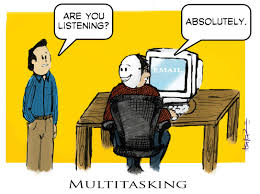Home » Misc
Category Archives: Misc
Is Multitasking Bad for the Brain?
Thank you to St. John’s for this great article on the potential negatives of multitasking. Multitasking is a great villain in many of our working, studying, and learning lives because it drapes itself in a cloak of usefulness, of productivity, when in fact it creates just the opposite: lowered efficiency, less productivity, poorer quality of work, and so on.
NPR has also recently come out with an article related to this issue: “We’re Not Taking Enough Lunch Breaks. Why That’s Bad For Business.” According to “We’re Not Taking…,” the pressure to not only multitask but to constantly be on-hand and on-the-clock is leading us as employees (and likely as students as well) to work longer yet less effective and less creative hours.

Just a brief stroll around the block could give you that boost of energy and creativity you need to finish the day strongly.
This might not seem to affect students quite as much given that elementary, middle, and high school students all have mandatory lunch breaks, but if you think your example of constantly being on the clock, of using lunchtime, dinnertime, breakfast time (all the time) as work time isn’t being seen and absorbed by your children, then you’re sorely mistaken.
As parents and teachers, we are the ones who lay the groundwork for our children; we’re the ones creating the rules and norms to be inherited by our young thinkers and students. So, if not for the sake of your own health and creativity, take a break for the sake of your kids’–take a break for the sake of their future, for your own happiness as well as theirs.
With the internet in our pockets these days, multitasking seems to be at an all-time high. I’m a big multitasker myself, especially when I’m at home. After work, I move a million miles a minute: washing dishes, packing breakfast and lunch for the next day, prepping dinner, and picking up around the house – all while checking email each time my phone beeps. I race through these tasks, often dropping food on the floor, and I wonder if doing so many things at once is helping me be any more efficient?
 According to countless research studies, it’s true that multitasking decreases your quality of work and slows you down. For example, writing an email and talking on the phone both use the same part of the brain. So, these competing tasks decrease the brain’s efficiency; you would be better off hanging up the phone and then taking the extra time…
According to countless research studies, it’s true that multitasking decreases your quality of work and slows you down. For example, writing an email and talking on the phone both use the same part of the brain. So, these competing tasks decrease the brain’s efficiency; you would be better off hanging up the phone and then taking the extra time…
View original post 226 more words
Talking About Race: Part One
Talking with kids about race-related issues can be very difficult. Today, it’s more important than ever to begin talking with them early on about race – but carefully, so as to not accidentally begin shaping old attitudes and assumptions in them. Here are just a few tips and suggestions for beginning such a conversation:
- Try asking your kids what they already know about figures like MLK or relevant news stories. Then let them lead the conversation. Don’t jump in early and don’t “correct” them unless their responses are blatantly hateful or prejudiced. It’s important that kids figure (some) things out for themselves and that you don’t make assumptions about what they know/don’t know or understand/don’t understand.
- Try watching an age-appropriate film with your kids that either touches on issues of race or that features leading actors who are racially different from them. (Examples: To Kill a Mockingbird or Remember the Titans, etc.)
- If you live in an area that’s not terribly diverse, make an effort to take your kids to events that are more diverse (though don’t comment on this motive to your kids). It’s only important that they experience the fullness of their country’s rich diversity as well as the diversity of their own local community firsthand. Again, don’t be the one to begin the conversation. If you think your kids might have questions, wait for them to ask.
- Take advantage of upcoming holidays like President’s Day (Feb. 16th) and Black History Month to learn with your kids about racial diversity and discuss how all people — no matter their race — are human and have the same human needs and desires—loves, hurts, cares, and dreams.
- Check out different relevant TED Talks like “Chimamanda Adichie: The danger of a single story”
Maker Movement in Classrooms?
First, I’d like to thank My School of Thought for posting such an excellent article on The Maker Movement. As a tutor and “maker” myself, I couldn’t be more thrilled by the take-off of this movement and am very hopeful for the future of our classrooms knowing that more and more teachers are beginning to incorporate more opportunities for students to build, explore, and engage with the materials they’re learning in new ways.
Just take Allen High School’s Blu Bistro, for example. When I was a student of AHS (I can’t believe how many years ago now that was!), cooking classes were basically nonexistent, but were in the works as a possible future extracurricular option for students. And now? Now AHS’ student chefs are not only serving restaurant-quality food of their own making to Allen community residents, but they’re also competing in kitchens across the state of Texas (in both cooking and restaurant management) including in the 2013 Texas Pro-Start Invitational state finals wherein dishes were judged by “members of the Texas Restaurant Association and chefs from culinary schools such as Le Cordon Bleu and The Culinary Institute of America” (Wendy Gragg, Waco Trib). These students are learning to be Makers of a different kind than the Engineering students we’ve started hearing so much about, but they’re Makers just the same. It’s in the art of being a producer that students can often start finding new interests and motivations for themselves to learn and become more active consumers.
As Dale Dougherty, editor of Make Magazine, explains in My School of Thought’s post, “…I want people to see themselves as producers, not just consumers. I’d like to see it become a capability that we use in home life and at work and that we’re proud of it, where we see ourselves as having these powers to do stuff.” I couldn’t agree more. Being a consumer, while fun, challenging, and interesting in its own right, is often today conflated with being more passive whereas being a producer seems to naturally mean being more active and invested in the product itself. But this does not always have to be the case. Rather, by encouraging children and friends to be more active producers, we can help them and ourselves become more active consumers as well.
We often see this in English courses where some students can have trouble getting interested in assigned readings yet leap at the opportunity presented by a creative writing project. Why is this? It isn’t because students are inherently lazy or come out of the womb not enjoying to read or don’t understand the connection between writing and reading — loving reading, loving science, loving learning (loving being a consumer of knowledge) are all things that must be taught and demonstrated for children from an early age. How can you be a creative writer without also learning to love and actively engage in the process of reading — in the process of consuming written materials? How can you be a builder without also learning to love and actively consume the necessary mathematics and scientific principles?
The answer is simply that you cannot — but you can sometimes begin as a producer and so work your way into becoming a more active consumer.
These two identities, these two ways of learning — producing and consuming — feed into each other in a natural cycle. So who’s to say that you need to have one first before the other can follow? Why not let kids try their hand at building or writing or cooking something before they’ve learned all the elemental pieces? — It might just be the kick-in-the-pants they need to start asking questions, to realize what might be out there for them to learn from the cookbooks, mathematicians, and libraries. And the best part is, if the students are the ones asking and seeking answers to their own questions, then they’re also learning to consume knowledge within a useful context and in a more active manner; they’re learning to consume and apply knowledge for a purpose, rather than simply memorizing facts because a school or standardized test demanded it (which can often lead to those facts seeming disjointed and useless). Learning information for a purpose or as part of a larger narrative of questions and exploration can often be key to that information being retained and applied in new ways. Our children learn from us — their mentors, parents, and teachers — what it means to have fun in one’s leisure time. If we spend all of our leisure time watching TV, then that’s what they, our children, will associate with down-time rather than more active and mind-engaging activities like reading, building, writing, or exploring.
And this is why we can’t leave the Maker Movement up solely to our schools and teachers. If we want our children to be more enthusiastic creators and more active consumers, then we must model this behavior for them and become more active and interested ourselves. This can be as simple as swapping out a night of television for a night of reading or puzzle-piecing or fort-building or creative writing or cooking or gardening or scavenger-hunting.
It can be as easy as learning to have fun with each other again.




 While these symptoms may sound obvious enough, they can actually be kept well-hidden by students (and often are) due to feelings of immense shame, fear, depression, and/or isolation. In order to detect and identify these symptoms, it is of paramount importance that teachers strive to develop a healthy rapport with their students, their students’ parents, and their fellow teachers. Without these clear lines and opportunities for honest communication, we won’t be able to recognize what’s normal for any given child and thus won’t be able to recognize significant changes (aka possible warning signs) either.
While these symptoms may sound obvious enough, they can actually be kept well-hidden by students (and often are) due to feelings of immense shame, fear, depression, and/or isolation. In order to detect and identify these symptoms, it is of paramount importance that teachers strive to develop a healthy rapport with their students, their students’ parents, and their fellow teachers. Without these clear lines and opportunities for honest communication, we won’t be able to recognize what’s normal for any given child and thus won’t be able to recognize significant changes (aka possible warning signs) either.









 But summer learning loss doesn’t only impact students—it also carries consequences for their teachers and their peers. Regardless of what many teachers try to do during the April/May school months, they’ll often find themselves wasting time in August/September re-teaching students all of the things they’ve forgotten during the summer months.
But summer learning loss doesn’t only impact students—it also carries consequences for their teachers and their peers. Regardless of what many teachers try to do during the April/May school months, they’ll often find themselves wasting time in August/September re-teaching students all of the things they’ve forgotten during the summer months.